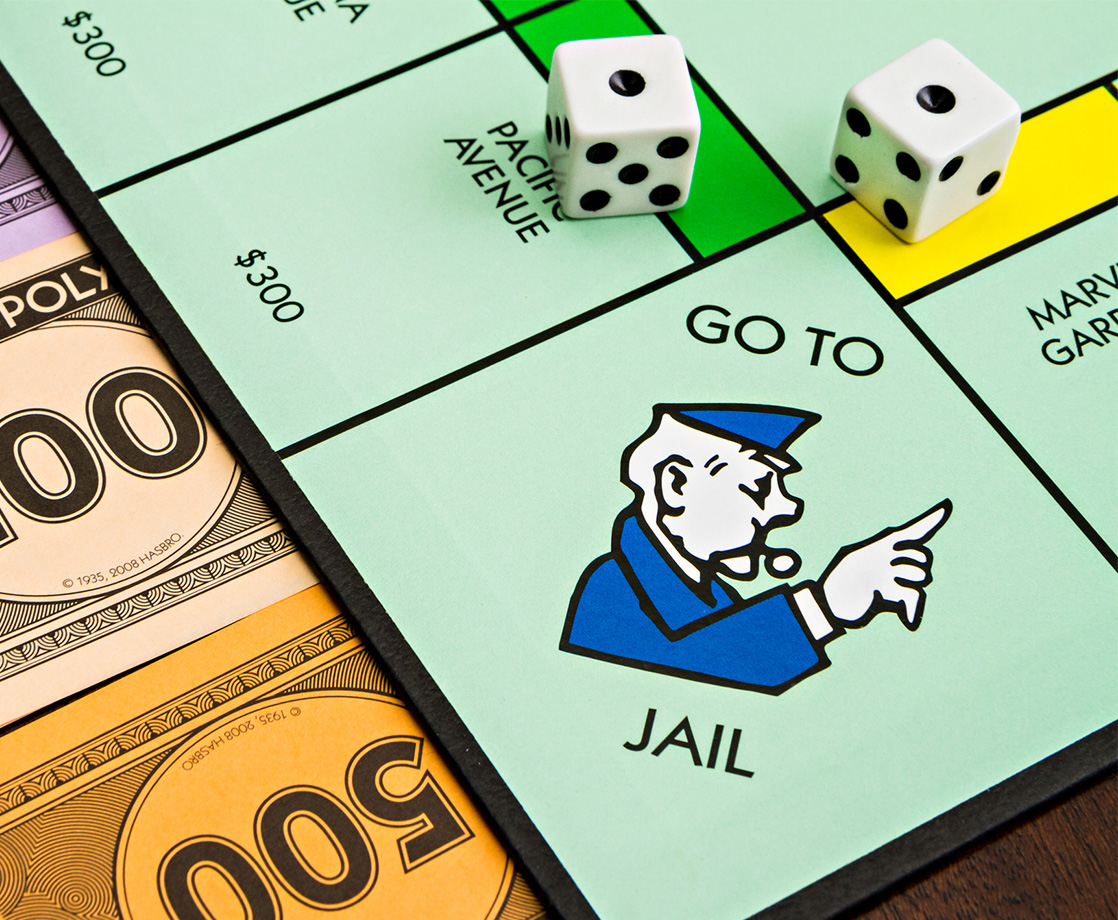Lead image via iStock Photo
The board game Monopoly wasn’t originally called Monopoly. Invented in 1902 by Elizabeth Magie as an ode to economic theorist Henry George, who advocated for a single-tax system, the game sought to highlight how landlords could accumulate wealth at others’ expense and why a sole land value tax was the best solution for the American populace. Magie called her handmade tabletop game, which relied on a mix of both luck and skill, the “The Landlord’s Game.”
“This is the game that would become Monopoly,” writes author Tristan Donovan in the new book It's All a Game: The History of Board Games from Monopoly to Settlers of Catan, out May 30 on Thomas Dunne Books. “But Magie's vision for the game was a world away from the internationally famous game it spawned.” The Landlord’s Game was intended to enable kids to observe “the gross injustice of our present land system” and help them develop into “adults who would campaign against it.” She pitched it to Parker Brothers, the biggest board game publisher, and they found it “too political and too complex.” It would take another three decades, several instances of intellectual property theft, and countless unapproved tweaks to Magie’s creation before her game was bastardized into the Monopoly we know today. The basic point Magie was trying to make was still there when it was rebranded in the early ‘30s, but by then the game had been perverted into a twisted form of capitalist nihilism. “If Monopoly seemed like a celebration of dog-eat-dog capitalism, that's because that is really what people wanted it to be,” writes Donovan.
The book explores the surprising and sometimes sinister roots of games like Monopoly, chess, and more, but also analyzes the ebb and flow of the public’s general interest in board games over the years, including why they’re having a popularity renaissance in the 21st century. In 2017 people are switching from tablets back to dice and cardboard, and games like Battle Ship, Risk, and Clue are captivating new players all around the world. Board games are more than just a pastime or momentary escape from the rigors of life, they’re social activities that encourage face-to-face communication and confrontation— something that’s sorely lacking in our modern day digital world. “In almost every other way, online gaming is inferior to board gaming face-to-face,” Donovan told MERRY JANE in an interview. “And that’s because communication isn’t just voice: It’s body language, it’s facial expressions, it’s eye contact.”
With chapters like “Tomb Raiders and the Lost Games of the Ancients," “The Game of Life: A Journey to the Uniquely American Day of Reckoning,” and “Trivial Pursuit: Adults at Play,” Donovan looks at the way board games have evolved across time in different cultures around the world, from Allied troops playing Monopoly in Nazi prison camps to luxe jet-setters being enraptured by backgammon to the myriad nations that have made tweaks to chess boards over the last several centuries. MERRY JANE caught up with Donovan to find out why board games are coming back into vogue, how artificial intelligence is increasingly outsmarting us at games like chess and Go, and why board games will survive, despite people being increasingly submerged in digital technology.

MERRY JANE: Why do you think tabletop board games are making a comeback today?
Tristan Donovan: Two reasons, I think. First, the games are better designed. In the past, the outcomes of games tended to be based on luck, such as the Game of Life, or on skill alone, like chess. But the newer games strike more of a balance between the two. That’s good because if it’s too much about luck then there’s no challenge, but if it’s all about skill then it’s a miserable experience if the players aren’t evenly matched. The second factor is that board games help us escape the stranglehold that tech has had over our lives in recent years. Board games bring people together face-to-face and requires them to focus on what’s happening at the table and the people in front of them rather than on their phone.
How are board games an integral and revealing part of human nature?
We were playing board games before the invention of the written word, so they go back deep into our history. What’s more, board games have fulfilled all kinds of roles throughout their history. They’ve been tools of religion, tools of war, and tools of entertainment. We’ve gambled with them, bonded with others by playing them, and learned how to be good losers and winners through them.
How have board games evolved over time and across various cultures?
Board games have been around for thousands of years. Until the 20th century, they were like folk music — something passed down and modified generation to generation, rather than a fixed work. Chess, for example, has undergone centuries of refinement and change. It started as a gambling game played with dice-like throwing sticks in India, but Hindu and Buddhist objections to betting turned it into a game of pure skill. The Persians added the practice of saying check and checkmate. The Arabs changed the pieces from literal figurines into more abstract creations. The Europeans turned the Queen into a super-powered piece.
The themes of board games have also changed with our culture. In the mid-1800s, many of the board games made in the US had a religious message. But come the 20th century, they became more about making money. More recently, co-operative games where players work together to win — or at the very least have to trade with each other to have a shot at winning — have become more common, which you could see as reflective of a move away from a dog-eat-dog attitude in society.
How are people using board games to test artificial intelligence?
Board games have been an important part of artificial intelligence research from the onset. For decades, making computers play chess as well as a human could was a big goal for AI researchers. This was because there were so many possibilities in the game that a computer couldn’t simply calculate every potential move in a game, so programmers had to develop rules of thumbs that computers could use to ‘think’ about how to play.
After IBM’s Deep Blue managed to defeat Gary Kasparov, the then-world chess champion, in 1996, the Chinese game Go became the new holy grail for AI research as it was even harder for computers to master. Of course, last year we saw Google’s AlphaGo AI become the first computer program to defeat a professional Go player without having a handicap. The task of developing these chess and Go AI’s spawned many of the key concepts and techniques used when creating artificial intelligence software.
[Editor’s Note: This past week, Google’s AlphaGo AI defeated China’s top Go master. “It isn’t looking good for humanity,” wrote the New York Times]
What is your personal interest in board games and what inspired you to write a book about the subject?
Board games were a big part of my childhood, so I’ve got many happy memories of playing board games like Monopoly, Game of Life, and Clue with my family. I also play the newer generation of boards games with a group of friends at my local pub every couple of weeks. So that long-standing interest was the primary reason for writing the book — I wanted to dig into the stories behind the board games that we played. In addition, I felt like it was a natural book for me to write given that I had already written a history of video games and I was also interested in finding out why board games had endured for thousands of years.
Did you discover anything surprising while writing the book?
Oh definitely. Probably the most surprising was learning that the attack on Pearl Harbor might never have happened if it wasn’t for the tabletop war games played by Japanese generals. Finding out about the Chicago toys and games mogul Marvin Glass was great, too. I hadn’t come across him before starting the book, but his company gave the world iconic games like Mouse Trap and Operation. He was such a fascinating character, a real-life Willy Wonka and a secretive genius with this deep sadness to him.
What do you want readers to get out of the book most?
I would like people to see board games in a different light, to see the games they play or played as a kid as being more than just trivial playthings. But more than that, I hope people find it an entertaining read with plenty of “I didn’t know that!” moments along the way.
What was Monopoly’s predecessor, The Landlord’s Game, all about?
It worked much like Monopoly. You’d win by accumulating land and then charging rent to other players in a bid to become the richest player. But it also came with an alternative set of rules designed to showcase how life would be better if a land value tax was imposed. Under this version of the game, when players landed on an undeveloped lot owned by another player, the rent went to the bank and landowners had to develop their land to profit from it. The Landlord’s Game wasn’t a commercial success, but lots of people enjoyed playing it and began making copies of it under different names and tweaking the rules as they went. However, in the process, the alternative rules and the deeper message got lost and it became Monopoly, a game where the goal is to become the last landlord standing.
What is the digital age generation missing from playing board games?
Face-to-face interaction is the key thing board games offer that digital games and communication cannot. Online play is vastly more convenient than having to get a group together in one place and then getting them to agree to play a particular game. But in almost every other way, online gaming is inferior to board gaming face-to-face, and that’s because communication isn’t just voice: It’s body language, it’s facial expressions, it’s eye contact. I think those inherent gaps in digital communication is why people tend to get angrier at each other when playing online games than they do playing a board game. That, and the fact that the person is only across the table and could punch you if you fail at behaving like a reasonable human being.
"It's All a Game" is out May 30 on Thomas Dunne Books. Pre-order it here.
Follow Seth on Twitter











